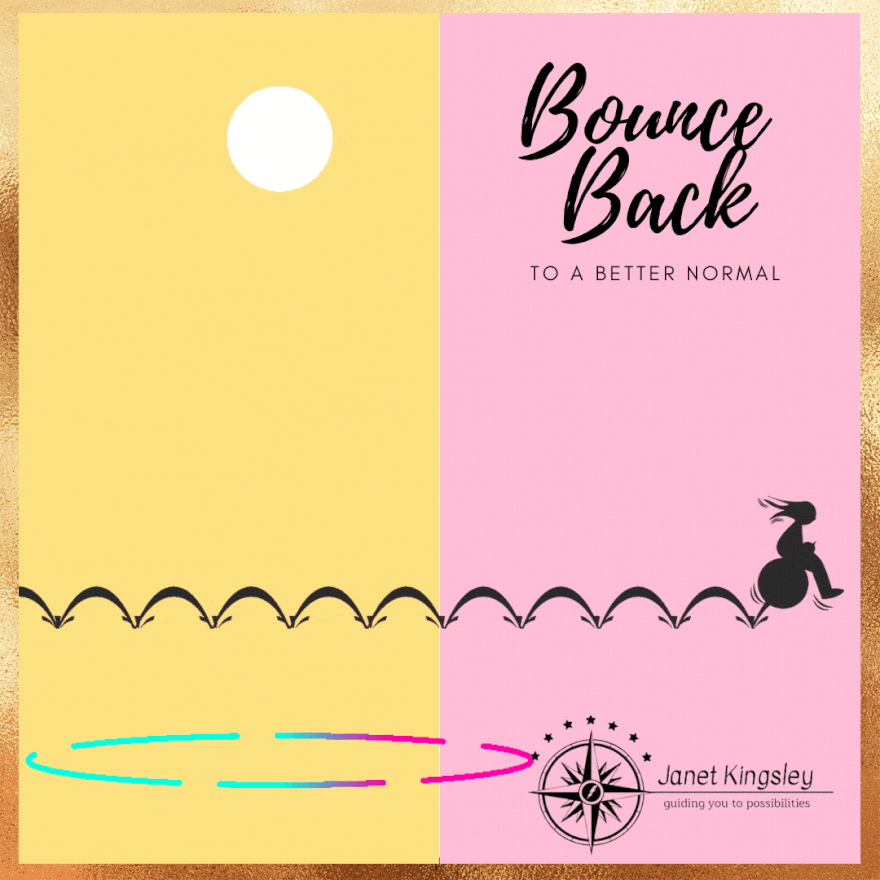Bounce Back to a Better Normal

Can you feel it?
I can feel the excitement, anticipation, and expectation as we head into July 2021. After 15 months of social distancing, masking, and staying safe in our home cocoons, things are opening up.
I have friends who are flying to visit family and friends. My season tickets to my local minor league baseball team have been activated. I’m attending several concerts this summer. We are bouncing back and ready to resume and embrace life as it was prior to COVID-19.
And I also have some friends who are not quite ready yet. They’re still experiencing pandemic fatigue and (IMHO) a bit of post-traumatic stress. They want to wait and see what will transpire when people throw off their masks (even those not vaccinated) and start hugging everyone around them.
And yet, they all agree they feel a shift. They feel an excitement and are anticipating 2021 to be better than 2020. Back to normal? I think we want ‘better than normal.’
In 2021, it seemed ‘normal’ and easy to forget our joy and passion; we were surviving. In 2021 it seemed ‘normal’ and easy to forget compassion and forgiveness; we were mired in judgment (okay, maybe not you, specifically, but many people). Negative news was all around and we seemed to eat it up even more than usual. In 2021, it seemed ‘normal’ to feel somewhat disconnected, alone, and isolated.
Enter July 2021 and a better ‘normal.’
I’ve taken some resiliency courses and the point of resilience is to help us Bounce Back Better. I like that. And yet, in order to bounce back better, we need to make a change from where we are now.
Change your thinking (keep it changed) and change your life. Change your thinking (keep it changed) and you can bounce back to a better normal.
How many times have you heard that before? A million? A gazillion? So, while the idea sounds great, the actual thought-changing part? Not so great.
Why? I think we don’t know where to start. Have you also heard that we have at least 60,000 thoughts every day? And most of those are the same thoughts we had the day before and the day before that? (and I want to know who counted, but I digress).
Anyway, how do we change 60,000 thoughts? Is that even possible? It’s overwhelming to think about it so we don’t even get started.
But here’s the good news: we don’t have to pay attention to, or change, all 60,000 thoughts.
Our thoughts are like a train. The locomotive leads the way and all the cars simply follow along. We only need to identify our key thoughts (our locomotive thoughts) and change those.
- If our “locomotive” thought is “I can’t afford it” what follows automatically?
- If our locomotive thought is “I never get any breaks,” what follows automatically?
- If our locomotive thought is “I’m not smart enough” or “I’m never in the right place” or “Life is hard” or “I hate my job” or “I am lonely,” what follows automatically?
What follows automatically is more of the same. Pretty soon, our thought train with hundreds of cars is zooming along at great speed and is difficult (or should I say impossible) to stop.
We need to be the engineer of our locomotive and learn to drive our own train. We’ve been on “auto-pilot” for too long. Most of us have more than one negative or limiting locomotive thought. That’s fine; just work on one at a time. Remember, if we think something it too overwhelming, we have a tendency to postpone and procrastinate.
Are you wondering which thought to start with? The easy one or the hard one? You get to choose. How awesome is that? The important thing is to choose and then begin.
Start by consciously re-framing your locomotive thought before it takes off. Maybe you can begin while brushing your teeth or taking a shower. And then see if you can remember this new thought hundreds of times per day.
And when your old thought-habit kicks into gear, the moment you notice, take that locomotive thought and re-frame it again and again. When you do, acknowledge yourself for noticing. And pay attention to the subsequent thoughts after you have re-framed your locomotive thought.
At the end of each day, assess your progress. Were you more aware? Did you notice your thought habit earlier? How easy or difficult was it to re-frame your locomotive thought? Did it get easier as the days went on? How did it feel to notice? Were you more successful in the morning or the afternoon? When was it the most challenging to pay attention to your locomotive thought?
I’m in. I plan on bouncing back to a better normal and by releasing one limiting idea at a time. I hope you’ll join me and let me know your results. Here are a couple of ‘bounce back to a better normal’ thoughts to try out:
- I am valuable and fabulous just the way I am
- I move confidently from confusion to clarity
- I attract vast sums of money
- It’s easy for me to make a difference just by being me
- I’m important enough to take time each day for self-love and self-care
Say YES to yourself by thinking new thoughts

P.S. I have a freebie that might help. It’s called “Mindset Mastery Made Simple” and it includes a daily checklist to help you notice your thoughts. You can download it by clicking the button below
FREE - Mindset Mastery Made Simple
About Janet
Janet is a transformational coach who helps women move beyond the negative voices in their head so they can unleash their purpose, unmask their self-confidence, and uncover possibilities that they have been blind to. Bottom line: she helps them to stop settling, start soaring, and experience the magic of their dreams again.


0 comments
Leave a comment